The Gemini South Observatory, using adaptive optics, has captured stunning new images of meandering stellar jets. The sidewinding appearance is likely caused by the gravitational influences of nearby companion stars. Plus, exoplanet news and a review of a Canon lens.
Podcast
Show Notes
Caught on camera: Stellar near miss
- NRAO press release
- “A likely flyby of binary protostar Z CMa caught in action,” Ruobing Dong et al., 2022 January 13, Nature Astronomy
Spacecraft updates: Swift in safe mode, JWST nears L2
- NASA’s Swift Observatory in Safe Mode – Team Investigating Possible Reaction Wheel Failure (SciTechDaily)
- NASA to Discuss Webb’s Arrival at Final Destination, Next Steps (NASA)
Starlink steps forward
- Elon Musk Offering Satellite Internet to Tsunami-Hit Tonga (Bloomberg News)
NASA’s TESS reaches TOI milestone
- MIT press release
Undergrad finds widely separate brown dwarf binary
- ASU press release
Soon-to-be destroyed planets found close to their stars
- Keck Observatory press release
- “TESS Giants Transiting Giants II: The hottest Jupiters orbiting evolved stars,” Samuel K. Grunblatt et al., to be published in The Astronomical Journal (preprint on arxiv.org)
Young stars have meandering jet set
- NOIRLab press release
- “High-resolution images of two wiggling stellar jets, MHO 1502 and MHO 2147, obtained with GSAOI+GeMS,” L. V. Ferrero et al., 2022 January 20, Astronomy & Astrophysics
Gas from outside galaxy will fuel stars inside
- ASU press release
- “How are Lyα Absorbers in the Cosmic Web Related to Gas-rich Galaxies?“, Sanchayeeta Borthakur, 2022 January 19, The Astrophysical Journal
Review: All-in-one lens for Canon full-frame mirrorless
- RF 24-240mm F4-6.3 IS USM (Canon)
Transcript
Hello and welcome to the Daily Space. I am your host Dr. Pamela Gay.
And I am your host Beth Johnson.
And we’re here to put science in your brain.
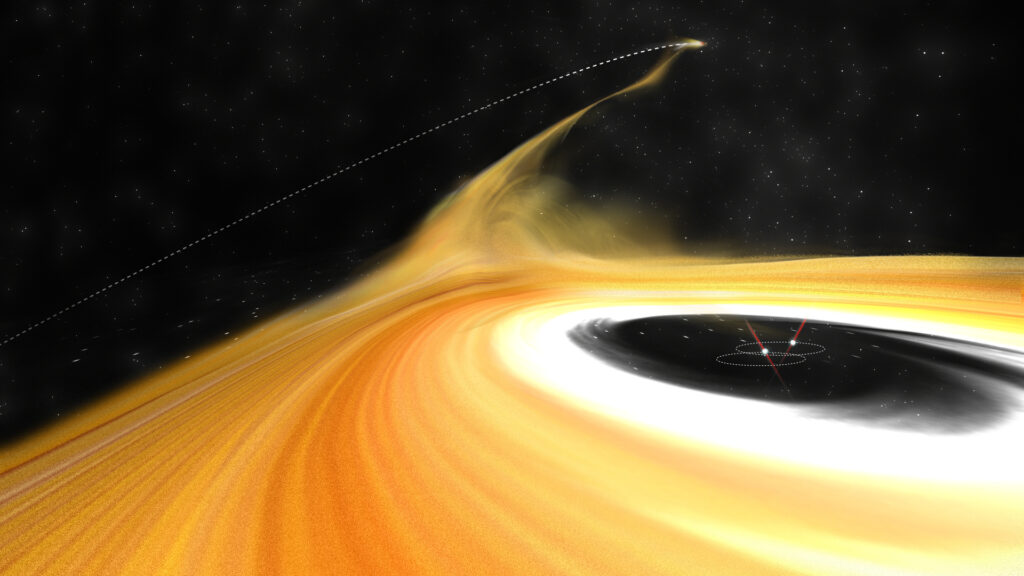
We work very hard with this show, and with our sister shows Astronomy Cast and Visión Cósmica, to talk about astronomical research that is grounded in observations. While we do cover a lot of computer models and theory papers, they generally are simulations that are confirmed by observations. Sometimes though, we have to recognize that the things our models reveal occur so fast that we might never manage to catch an event in real-time, and we accept what model after model shows as being true because everything makes sense and there are no contradicting observations.
Consider star formation. Stars form in dense clusters where everything is in motion. Computer simulations and basic reasoning have long said that these environments, like busy city streets with broken traffic lights, should be rich in near-collisions. With stars, these near-collisions can toss about planets, trigger comets, and otherwise make a hot mess of a young star system. It all made sense; it’s just no one had ever seen it happen.
But sometimes, we all just happen to get lucky with the timing of our photos, and one of these collisions has now been observed by the Very Large Array and Atacama Large Millimeter/submillimeter Array (ALMA). This system, Z Canis Majoris, was distorted during the event, with a long arm of gas now reaching out toward the side swiping star. According to project researcher Hau-Yu Baobab Liu: These perturbers not only cause gaseous streams but may also impact the thermal history of the involved host stars, like Z Canis Majoris.
Project lead Ruobing Dong adds: Studying these types of events gives a window into the past, including what might have happened in the early development of our own Solar System, critical evidence of which is long since gone. Watching these events take place in a newly forming star system provides us with the information needed to say, ‘Ah-ha! This is what may have happened to our own Solar System long ago.’ Right now, VLA and ALMA have given us the first evidence to solve this mystery, and the next generations of these technologies will open windows on the Universe that we have yet only dreamed of.
This work is published in Nature Astronomy.
Astronomy and planetary science advance one spacecraft and ground-based observatory at a time. Sometimes, it feels like the engineers give and the gremlins take, and this is one of those days.
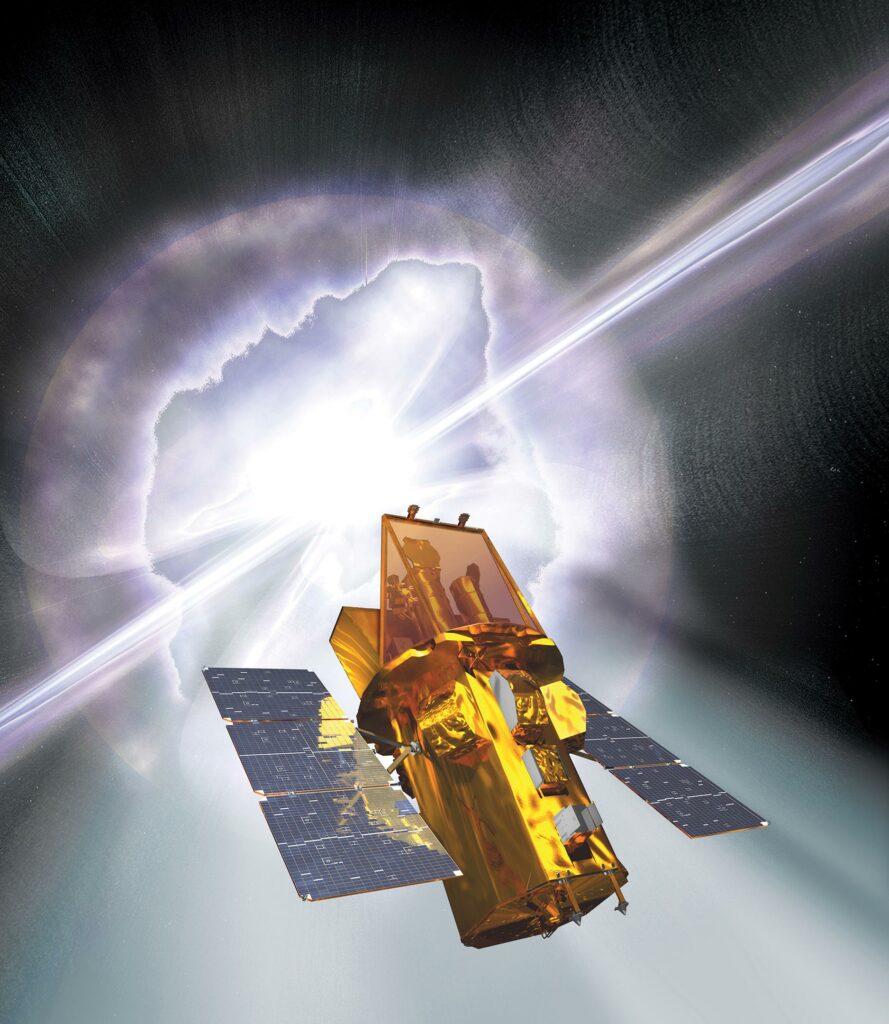
The 17-year-old Swift space observatory is a workhorse for gamma-ray burst discovery. It has the ability to take images with three telescopes that sprawl the electromagnetic spectrum from gamma rays to visual wavelengths. This allows it to spot events in high-energy gamma-ray light and then identify their exact location precisely with the X-ray and visual/ultraviolet telescopes.
With age, spacecraft wear out, and it looks like one of the six reaction wheels on board has finally worn out, and the spacecraft has entered safe mode. Reaction wheels are used to point space telescopes, and over the years, NASA has expertly gotten past missions to work on as few as two reaction wheels. It is hoped that Swift will similarly be able to get back to work and continue its amazing science quickly.
While Swift struggles, we see JWST preparing to hit its next big milestone: arriving at its destination, the gravitational sweet point beyond Earth where the pulls of the Sun and Earth will allow it to pace us in orbit around the Sun. On Monday, JWST will fire its engines to make its final course corrections into its parking orbit in this busy spot full of missions including Gaia, Planck, and the now quiet Herschel.
Just as we were finishing up today’s show, we got an update on news from earlier this week. On Tuesday, I said it was time for Starlink to show its mettle and step up to help with communications in disaster situations. According to Bloomberg News, Elon Musk is offering to send Starlink terminals to Tonga. We can only hope that this happens and that this is an aid package and not a business package. As we learn more, we’ll update you here on the Daily Space.

And now for all the exoplanet news you can handle.
First up, MIT’s Kavli Institute for Astrophysics and Space Research announced yesterday that the TESS object of interest (TOI) catalog has passed 5,000 planet candidates. I think that means it’s only a matter of weeks before the confirmed exoplanet count surpasses that mark as well. As it stands, per the Exoplanet Archive, there are 4,903 exoplanets as of January 10.
Currently, the TESS mission is in its first extended mission, which is expected to run until at least 2025, and their catalog of candidates has more than doubled in the past year. TOI manager Katharine Hesse noted: With data from the first year of the extended mission, we have found dozens of additional candidates to TOIs found during the prime mission. I am excited to see how many multi-planet systems we can find during the rest of the extended mission and in upcoming years with TESS.
Congratulations to the TESS team. We look forward to thousands more candidates in the future.
When it comes to exoplanet discoveries, I’ve remarked several times in the past few months that we have reached the point where the only discoveries being announced with press releases are either massive data dumps from machine learning programs or the strange, weird, and unusual discoveries. This story is definitely the latter.
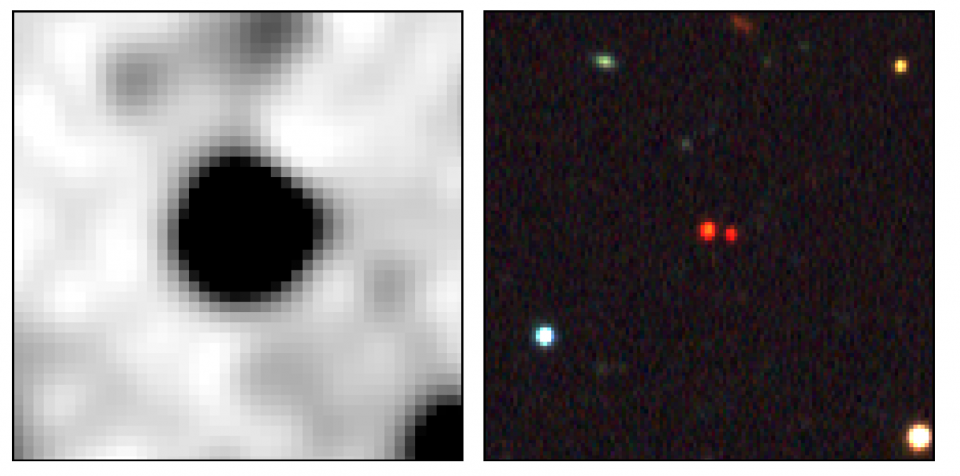
Undergraduate student Emma Sofich from Arizona State University recently led a team that studied data in the Backyard Worlds: Planet 9 citizen science project, and they found a brown dwarf binary system. Finding brown dwarfs is pretty amazing in and of itself, but this system has even more going for it – it’s the most widely separated pair in a binary system ever found. The two planets – failed stars? – are 129 astronomical units apart.
The system is called CWISE J014611.20 050850.0AB, and the results were presented at last week’s American Astronomical Society (AAS) press conferences with a paper to be published in The Astrophysical Journal.
Also announced at last week’s AAS press conferences was the discovery of three planets that are teetering on the brink of destruction because they are orbiting dangerously close to their parent stars. One of these planets, TOI-2337b, has less than a million years to survive, making it the most endangered known planet.
The threatened planets were found in NASA TESS image data from 2018 and 2019. Follow-up observations were performed using a spectrometer at the Keck Observatory in Hawai’i to confirm the planets.
In a paper accepted to The Astronomical Journal, researchers presented detailed estimates of the planets’ masses and sizes, with mass ranges of 0.5 to 1.7 times Jupiter’s mass and size ranges from just less than Jupiter’s size to 1.6 times its size. Basically, a bunch of Jupiters, really. Gas giants everywhere!
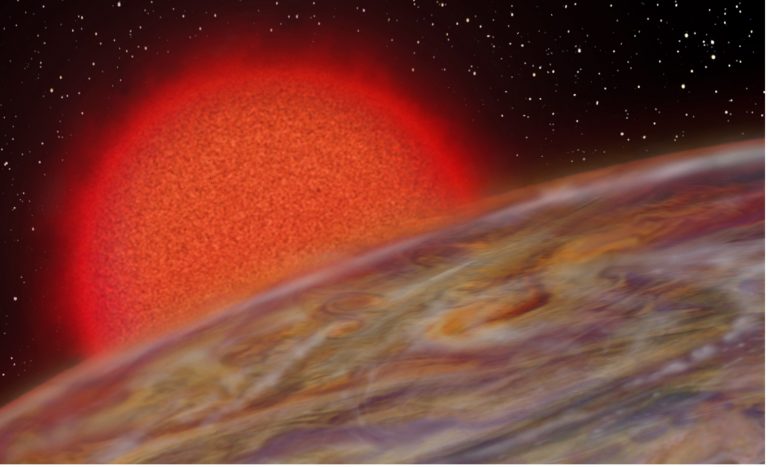
Densities for the planets range from styrofoam-like to about three times as dense as water, which means these planets have different origin stories across the board. That’s pretty cool and kind of frustrating because it adds more complexity to our planetary formation hypotheses. Honestly, there may be too many variables to come up with one cohesive formation theory. We’ll likely have to tailor potential outcomes based on the parent star’s age, type, how big the protoplanetary disk is, which way the winds were blowing through the gas cloud that formed the star itself. I could go on and on.
But the main objective in studying these three planets, and the potential hundreds to be found later, is to understand the end of life for a planet. Per the press release, Current models of planet dynamics suggest that planets should spiral in toward their host stars as the stars evolve over time, particularly in the last 10 percent of the star’s lifetime. This process also heats the planets, potentially causing their atmospheres to inflate. However, this stellar evolution will also cause the orbits of planets around the host star to come closer to one another, increasing the likelihood that some of them will collide, or even destabilize the entire planetary system.
Now we wait for some time on the JWST to gain some insight into what the planets’ atmospheres are made of – water, carbon dioxide, etc. That would help researchers put some constraints on the formation of these worlds and what sorts of interactions might have led them to where they are today. Planetary formation, it seems, is messy.

Space is messy. Gas and dust obscure a lot of cool objects behind walls of either opaquely dark or heinously bright materials, and while we know there is stuff in and behind the mess, figuring out what it is requires a fair amount of sleuthing. Sometimes, we get lucky, though, and the hidden objects make themselves known by screaming out flares of light and material that point back to dramatic events. Baby stars, like human babies, are particularly good at screaming.
Recent observations by the Gemini South Telescope looked at a variety of regions containing star formation, and in two very different environments, young stars found ways to make their presence known.
The system MHO 2147 is a cold dark cloud that blocks the light from objects inside and behind it. We know this system hides a young star that is spinning like an unstable top because we see a pair of helix-shaped jets. As material falls into the young star, it forms a hot disk, and the star generates a magnetic field that in turn flings materials out in jets. The jets point in the direction of the star’s rotational pole, and these helix-shaped jets mean that the star is slowly tracing out a circle with its pole, just like a top spun imperfectly may do.
In a very different region of the sky, MHO 1502 lurks in a bright region of ionized hydrogen gas that is heated by young massive stars. This system is spinning out a dashed line of material, indicating that whatever is happening is turning on and off with time. It is thought this system is actually two stars.
We all leave traces as we move through our lives, both humans and stars, and sometimes, a lot can be learned from these traces, even when we do our best to hide.
The gas in both those two systems will someday be exhausted as stars form, planets form, and together they draw material from their surroundings and use light pressure to blast away any leftovers.
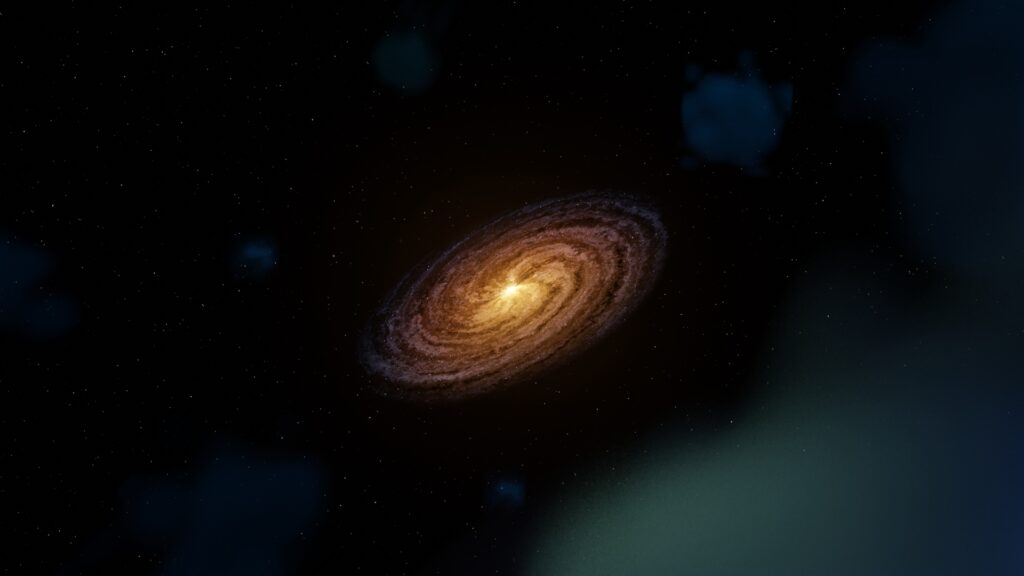
Over time, our galaxy will stop forming new stars unless new gas is introduced, and a new paper published in The Astrophysical Journal and led by Sanchayeeta Borthakur indicates that our Milky Way will have the ability to refuel, at least for a little while. Using archival data, she found faint traces of gas in the space beyond our main galaxy. She explains: Observations of galaxies are similar to looking through an airplane window at night and seeing bright city lights surrounded by darkness. Finding this fuel source is like discovering that in the darkness lies the farms and supply routes that support the populations in the cities.
In follow-up research, Bothakur plans to study how that gas can fall into the Milky Way and make its way all the way to the galactic core. She goes on to explain: Galaxies like ours will continue to grow by forming many more solar systems as new material comes in. Understanding the source of the star fuel allows us to predict if new stars will be formed in the future.
It is amazing what can be found in the amazing archival data set aside by numerous telescopic surveys. It is also amazing what you can see for yourself with just a good lens and tripod.
Next up, Erik Madaus will be presenting a review of a Canon RF 24-240mm all in one zoom lens.
Review

The lens I’m gonna be reviewing this week is yet another lens for Canon’s full-frame mirrorless system, the Canon RF 24-240mm all-in-one zoom lens. I got this lens as part of a kit with my EOS RP.
You usually see all-in-one zooms like this on APS-C cameras. Indeed when I had a Nikon D3100 a DX 18-300mm was on it almost all the time, providing a 27-450mm equivalent. I like the 24-240mm because I can go out taking relatively wide-angle shots and still have a lot of reach with just a twist of my wrist if I see some animal.
The purpose of a lens like this is to cover almost all of the focal lengths you might need in one convenient package so that you don’t need to change lenses while in the field. Many people could be fine owning just this lens. The compromises you make to get this capability are cost ($899 by itself, less when purchased in a kit), weight (750g), and small aperture (f/4-6.3).
For the longest time, this was the only lens I had for my RP, and I was frustrated by needing to crop a lot for wildlife, but that’s not the purpose of this lens. A few months later, I got my 600mm prime made for wildlife and loved it. Since getting it, I’ve hardly used this lens — less than 500 pics in a year versus nearly two thousand with the 600. I also prefer primes because the industry-standard clockwise zoom rings aren’t comfortable for my left-handedness.
The usability of this lens is better than its image quality, except for when you need manual focus. It has great build quality, but typical for a non-L lens there is little to no weather sealing so don’t go dunking this lens in the mud. The zoom ring is most of the lens, so it’s very easy to make small adjustments. I don’t notice any zoom creep, but there is a lock button that keeps the lens at 24mm which I use for storage. It’s relatively compact when fully retracted.
Like other cheaper RF lenses, it has a combination manual focus and function control ring. This one has click detents. This requires the user to dig into the menus to choose the manual focus and reverse the process to go back into autofocus mode. However, the 24-240mm has Canon’s top-tier fast and accurate Nano-USM motor, so you really never need to switch into manual focus unless it gets very confused.
It’s unusual to have a lens with such a wide focal range on a full-frame sensor because the lens must cover a bigger image circle. All-in-one lenses also usually have lots of distortion of different types along with the focal length range and, oh boy, does the Canon RF 24-240mm have distortion.

I’ve talked about the image quality in reference to other lenses before, but now here’s more detail. At 24mm, the lens image circle does not cover the full sensor, so instead of being dark, the corners are completely black. The camera does image processing to stretch the image to cover the corners, leaving them looking pretty soft and low-res. All but the corners of the image are pretty sharp though.
The image stays digitally stretched until about 70mm. It’s good for the rest of the focal range. Of course, there’s barrel distortion at the tele end like all zooms, but it’s not as severe as the vignetting and pincushion distortion on the wide end. It’s corrected in-camera so you’ll never notice it unless you shoot RAW and edit in non-Canon software.
My biggest problem using the lens, and why I can’t really recommend it, is its size and weight. It’s 750 grams without a hood and 122 mm collapsed. It plus my RP and strap just barely fit into my normal size camera bag, making it a hassle to get out and making me leave the bag with its spare batteries and memory cards in the car. The size is also awkward to carry around; I usually have to keep a hand resting on it to prevent everything from swinging around when I’m walking, even with it cross-body. Another thing is the lens hood is fiddly to put on and remove, so I keep it on all the time which makes it even longer.
Unless you really need this focal range in one lens, I would recommend getting the smaller and lighter 24-105mm f/4-7.1 and spending the money you saved on an RF 100-400, a lens that didn’t exist when I first got my camera and this lens. The RP is a pretty small camera, so it doesn’t really make sense to pair it with a bulky lens like the 24-240mm. The 24-105mm f/4-7.1 is a good lens for what it is, but it’s more expensive than I think it should be. However, you can get it for a reasonable price as part of a kit, or even cheaper than that used.
This has been the Daily Space.
You can find more information on all our stories, including images, at DailySpace.org. As always, we’re here thanks to the donations of people like you. If you like our content, please consider joining our Patreon at Patreon.com/CosmoQuestX.
Credits
Written by Pamela Gay, Beth Johnson, and Erik Madaus
Hosted by Pamela Gay, Beth Johnson, and Erik Madaus
Audio and Video Editing by Ally Pelphrey
Content Editing by Beth Johnson
Intro and Outro music by Kevin MacLeod, https://incompetech.com/music/


 We record most shows live, on Twitch. Follow us today to get alerts when we go live.
We record most shows live, on Twitch. Follow us today to get alerts when we go live.